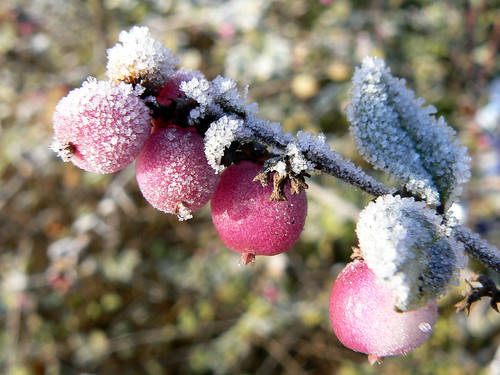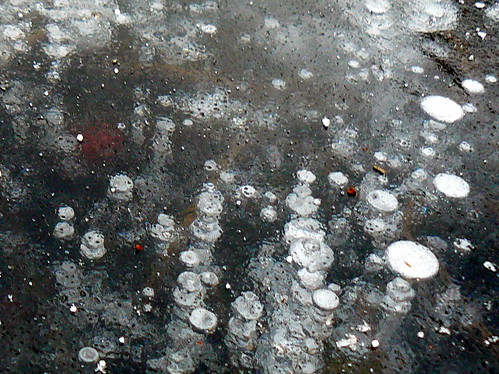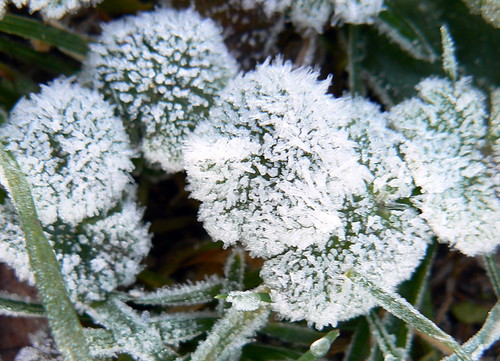The contrast between Here, in summer, and There, in winter, demonstrates the sort of extremes plants must tolerate in different ecosystems. I was fascinated by the sight in the Netherlands of plants coated in frost, and indeed, frozen in solid ice.
My mother-in-law's pond. Embedded in the ice are water lilies, and
beneath, just visible, are goldfish, content in the knowledge
that water expands when frozen and insulates them from
the air temperatures above.
Now, if you're from somewhere that has winters like these, you probably think I'm a parochial git for being so entranced by the novelty of plants coping with a serious winter. But from my balmy (ahem.... meteorologically speaking), temperate Sydney perspective, it's simply extraordinary.beneath, just visible, are goldfish, content in the knowledge
that water expands when frozen and insulates them from
the air temperatures above.
A little reading (see below) on the subject has been very enlightening.
In order for plants to tolerate freezing, they must first undergo cold acclimation. A plant that has not been exposed to non-freezing cold might die at around -5C, while the same species that has been cold acclimatised can survive to -30C. This sort of temperature trigger is common in plants. Temperature changes induce flowering and seed production, and winter dormancy--as does changing day length.
The damage caused to plants by freezing occurs in cell membranes, with ice crystals forming in the spaces between the plant cells. This draws fluid from within the cells to these intercellular spaces. As a result, the cells become dehydrated, and this in turn damages the membranes themselves. One form of this damage is to the lipids--fat-soluble molecules--which help provide cell membrane structure. Cells can also rupture as a result of ice forming adhesions between cell walls and membranes. Further injury to the plant is possibly caused by protein denaturation, where the complex three-dimensional folding structure of a protein molecule is disrupted.
So how do some plants survive freezing temperatures and avoid this damage, and how does cold acclimation facilitate this?
It's been established that cold acclimation can change gene expression--that is, it triggers the replication of particular genes within the plant and thus the production of specific enzymes (proteins that act as a catalyst in a chemical reaction). A range of genes examined have various effects: some encode for a protein that alters lipid composition while others stabilise proteins against freeze-induced denaturation. There are many other genes expressed as a result of cold acclimation whose roles are not yet determined. In addition, low temperatures trigger a signal transduction cascade--essentially a domino effect of proteins acting upon each other within a cell. Calcium pours into the cell cytoplasm, triggering processes that induce gene expression.
None of this is going to have much import in my garden, whose main duty will be to stay alive during the increasing drought and heat of climate change. Still, looking at photos of chilly plants is a fine way to cool down!
A clover plant by the side of the road in Belgium,
just before the snow dumped on it.
just before the snow dumped on it.
Reference: Thomashow, M.F. 1999. Plant Cold Acclimation: Freezing Tolerance Genes and Regulatory Mechanisms. Annu. Rev. Plant Physiol. Plant Mol. Biol. 50:571–99. LINK.




4 comments:
Those are some great photos!
Thanks, Christie, and thanks for visiting!
Hi Margaret, Thanks for tagging me, it looks like fun. I really enjoyed these icy pictures and learning about how plants acclimate to the cold. You've got a lot of fascinating posts here. I'm glad I stumbled upon your blog!
Hi Diane,
Thanks--and I'm enjoying your blog too. You and I live in thoroughly different climates, and are both into flora, so I think we make a nice bloggy-balance!
Hope you'll keep visiting.
Post a Comment